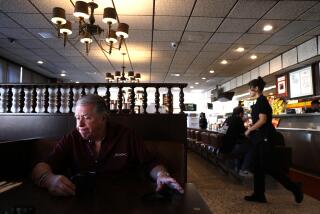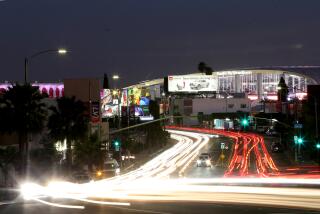The Return of the Village People?
A guy I know used to live in Westwood, back when living in Westwood was really something to talk about.
It was the early 1970s, and when he recalls it, his voice still goes wistful, as if his return address had once been Camelot. There were little shops, he says, and little hardware stores. OK, the restaurants weren’t great, but back then no place in L.A. had great cuisine. The atmosphere was the thing: Mimes and bookstores and Hare Krishnas and UCLA beer halls and so many people. He once ran into Donald Sutherland shopping for a steam iron. It was that kind of place.
Then something happened, and it seemed to happen all of a sudden, though common sense would tell you it would have to have been in the works for a while. From one Friday night to the next, it seemed, Westwood ceased to be a place where anybody wanted to come. There was a tragic gang shooting there, but anyone who’s spent any time in this city knows that an isolated gang shooting never single-handedly killed an entire scene. Something else was going on. I remember going there one weekend for a plate of fettuccine and having to literally plow through the people. Two years later, the restaurant I’d waited an hour to get into was shuttered and the entire block was stripped of vitality.
What went wrong? Of all the mysteries of this city, the mystery of Westwood seems most to tug at Southern Californians’ hearts. I’ve heard Orange County suburbanites who’d happily bulldoze their homesteads to make way for condos sigh over Westwood like Citizen Kane pining for Rosebud.
Everyone has a theory, and lately, the theories have seemed pertinent because Westwood is in the throes of yet another campaign to bring it back. It’s poignant, this battle, because running through it is Southern California’s eternal dilemma: How do you experience the community a great city can offer when part of you is afraid to open up and connect?
*
At one level, what’s happening in Westwood is your typical developer vs. local activist tale. Many personalities. Much suspicion. Spin galore. The short version is that a couple of projects are taking place on parallel streets, one involving a general face lift on Westwood Boulevard, and the other involving an $84-million mega-development a block over on Glendon Avenue.
Everyone loves the face lift. They like the cobblestone and foliage. Several good, high-end restaurants are coming in. But over on Glendon, it’s a different matter. The project there, known as Village Center Westwood, has been embroiled in squabbling for three years, and if it ends up ever being approved by the City Council, the opponents have threatened to tie it up in court for years to come.
Which is too bad. Some locals don’t like the developer, Ira Smedra, a guy whose projects have tended toward the dispiriting stucco-box genre. But Village Center isn’t as bad as all that. There’s an open-air plaza with architecture that matches the rest of the village. There are palm trees and boutiques and movie theaters and outdoor cafes.
Glendon--a listless street that runs between the Monte’s building and Macy’s--would be closed and turned into a pedestrian plaza. There’s a library and an outdoor amphitheater with space at the bottom for a supermarket and underground parking garage. There are congestion issues, but it’s better than what’s there now, namely a parking lot.
But there seem to be deeper issues too, involving control of Westwood’s direction and style. The project flies in the face of a specific plan that the locals spent five years hammering out in the ‘80s, when Westwood was so popular that the crowds had them overwhelmed. Smedra wants crowds, and that’s the rub for Westwood. They want the bustle, but they’re afraid of losing control again.
*
Who knows whether such fear is unfounded? The pessimists claim things are so far gone, Westwood will be lucky if people ever come back from Old Pasadena and the Third Street Promenade; the optimists say the place is coming back with or without the project, now that the economy is stronger again.
But this debate misses the heart of the matter. I know another old villager who claims Westwood went downhill when they cracked down on the street musicians and artisans years ago. Part of the charm of the place was its ability to surprise you, he says; that went out the window when people got hung up on control.
A great city is more than specific plans versus stucco. People loved Westwood because, like few corners of this metropolis, it once had an identity. That identity would be priceless if Westwood could relax again and stop bickering. I hear there’s a real market for personality.
Shawn Hubler’s column runs Mondays and Thursdays. Her e-mail address is shawn.hubler@latimes.com
More to Read
Sign up for Essential California
The most important California stories and recommendations in your inbox every morning.
You may occasionally receive promotional content from the Los Angeles Times.










